The invention that inspired a New York tradition
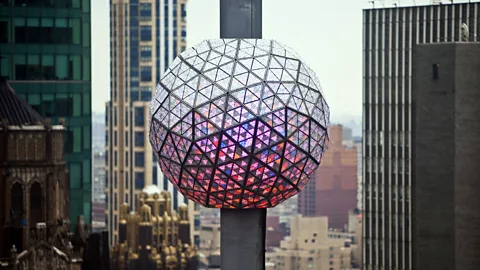 Ramin Talaie/Getty Images
Ramin Talaie/Getty ImagesA British Royal Navy officer named Robert Wauchope is credited with creating the time ball, an ingenious Victorian-era contraption that inspired New York’s New Year’s Eve ball drop.
When the final hours of the year arrive, a million celebrants will crowd Times Square in New York. Elsewhere, an estimated billion more will tune in to watch the annual spectacle celebrated across the globe.
As the year reaches its last 60 seconds, all attention will focus on a descending Waterford crystal-encrusted, five-tonne ball flashing with more than 30,000 LEDs. When it reaches the bottom of a specially designed flagpole, Champagne corks will pop. There will be cheers, toasts and kisses as celebrants embrace the promise of a new year.
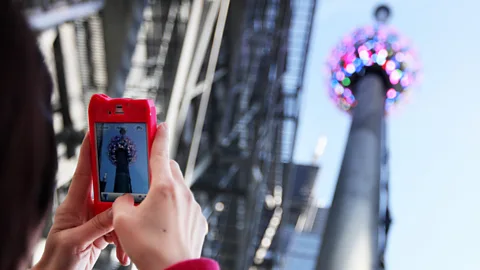 Mario Tama/Getty Images
Mario Tama/Getty ImagesBut few will acknowledge the man who really deserves their praise, a deeply religious British Royal Navy officer named Robert Wauchope.
Wauchope is credited with creating the time ball, an ingenious Victorian-era contraption that inspired the Times Square blowout. It’s doubtful that the man who titled his autobiography “A Short Narrative of God's Merciful Dealings” would appreciate the connection. The invention was inspired by navigation, not intoxication.
You may also be interested in:
• Turkey’s magical hangover cure
Wauchope’s goal was to make shipping safer. In the early 19th Century, having the exact time was crucial knowledge for mariners. It was only by keeping a ship’s clock precisely calibrated that sailors could calculate their longitude and accurately travel across oceans.
His ball, first demonstrated in Portsmouth, England, in 1829, was a crude broadcast system, a way to relay time to anyone who could see the signal. Typically, at 12:55, a creaky piece of machinery would raise a large painted orb halfway to the top of a pole or flagstaff; at 12:58, it would proceed to the top; and precisely at 13:00, a worker would release it to drop down the pole.
“It is a clear signal,” said Andrew Jacob, a curator who operates the time ball at the Sydney Observatory in Australia. “It’s easy to see the sudden movement as it begins to drop.”
Before the time ball’s invention, a ship’s master would typically come ashore and physically visit an observatory to check his watch against an official clock. Then he would quite literally bring time back to the ship. Wauchope’s invention let sailors calibrate their shipboard timepiece, called a chronometer, without leaving their boat.
“We’re so used to time being here and available, and that wasn’t always the case,” said Emily Akkermans, who has the enviable title, Curator of Time, at the Royal Observatory in Greenwich, London. The museum and historic site houses the world’s oldest operating time ball, which since 1833 has dropped daily, barring blustery weather, war or mechanical breakdown.
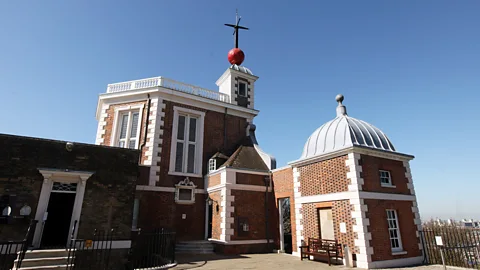 Oli Scarff/Getty Images
Oli Scarff/Getty ImagesAlthough noon might seem a more fitting time for a signal, that was once rush hour for observatory astronomers who were tracking the sun’s position at midday to set their own clocks. Waiting an hour, until 13:00, proved to be much less hectic.
Greenwich’s ball inspired hundreds more around the world, from Jamaica to Japan. The devices were typically located at a high point near a port, atop an observatory, lighthouse or tower. And for just under a century, these time-signalling devices flourished.
The idea even took off inland. “It wasn’t all for navigation,” Akkermans said. “Some time balls were operated by shopkeepers who were selling watches to the public.” In Barbados, a 09:00 ball drop signaled the start of class to students across the island, she said, citing a 1888 article in Illustrated London News.
But today, there are only a few places to see a time ball in operation.
Eighty miles from Greenwich, another time ball drops regularly in the coastal town of Deal, near the spot where the English Channel meets the North Sea. It was the first tower linked to Greenwich by electric line allowing it to relay the official Observatory time to mariners, although nowadays it relies on a signal from the British atomic clock. From April through September, the ball drops hourly from 09:00 to 17:00. And it too marks New Year’s with a special midnight performance on 31 December.
Jeremy Davies-Webb, chairman of the Deal Museum Trust, says he knows of four other working time balls aside from Greenwich, Deal and Sydney, although on any given day it’s possible they won’t be operating due to weather conditions or breakdown.
 John Lawson/Getty Images
John Lawson/Getty ImagesThe others are in Edinburgh, Melbourne, Christchurch and Gdansk. He’s visited all but Melbourne’s, and is particularly fond of the one in Poland, which punctuates its drop with a fanfare of trumpets.
“We wanted to do that, but our neighbours would complain bitterly,” he said.
Anna Rolls, curator of the Clockmakers' Museum in London, worked with Greenwich’s time ball for several years. “It’s such an odd-looking thing,” she admitted, an elaborate mechanism that provides “something so easily obtainable today”. Yet it’s exactly that, she suspects, which accounts for its appeal.
Indeed, each working time ball has its own lore.
Greenwich’s ball, which measures some 1.5m in diameter and is made of aluminium, is covered in dents, the result of a misunderstanding. In 1958, workers, apparently unaware that the ball had been taken down for a temporary renovation, were seen kicking it around the observatory courtyard in an informal game of football.
In Scotland, the ball drop from Nelson Monument is overshadowed by the One o’Clock Gun, which fires from Edinburgh Castle. The gun was also meant to convey the time to ships but is less accurate than a time ball because sound travels at a relatively slow at 1,235km/hour, meaning that several seconds could pass before a mariner heard the volley.
In the Melbourne suburb of Williamstown, the time ball tower has bounced through various roles. The square bluestone lighthouse at Point Gellibrand opened in 1849, just in time for the city’s gold rush, but a decade later was converted to a time ball tower. In 1926, the keeper, who had dutifully dropped the ball for 37 years, died, and with no complaints about the interruption of service, the time ball was retired, according to the preservation group Lighthouses of Australia. More recently, local charities have renovated the machinery and the ball now again drops daily.
In Lyttelton, New Zealand, the time ball tower collapsed after the 2011 Christchurch earthquake. But a fund-raising campaign helped rebuild the handsome stone heritage structure, which resumed drops in November 2018.
And it’s said that German soldiers in 1939 claimed the upper floors of the Gdansk tower, where they installed a machine gun battery and fired the first shots of World War Two.
Other non-functioning balls still top buildings across the globe, from the waterfront of Cape Town to the US Naval Observatory in Washington DC.
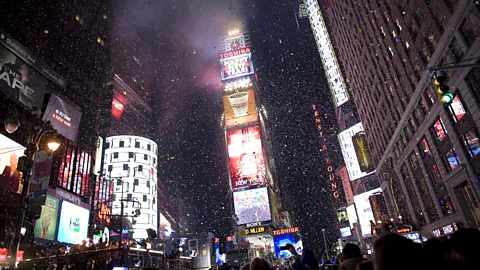 Brian Harkin/Getty Images
Brian Harkin/Getty ImagesAs for the New Year’s connection, that came in 1907. The New York Times newspaper had instituted a midnight celebration in Times Square several years earlier, punctuated by dynamite and fireworks. After authorities banned the explosives, promoters needed something splashy to mark midnight and found inspiration in New York’s popular Western Union Telegraph’s time ball, which had been operating on the roof of the company’s Broadway headquarters since 1877.
The newspaper constructed an impressive orb weighing 700 pounds and covered with 100 25-watt lightbulbs. But in the spirit of showmanship, organisers altered time ball protocol, making the crucial moment of demarcation the moment the ball landed, not when it was released.
The party trick was an immediate success. As the newspaper reported the next day: “The great shout that went up drowned out the whistles for a minute. The vocal power of the welcomers rose above even the horns and the cow bells and the rattles. Above all else came the wild human hullabaloo of noise, out of which could be formed dimly the words: ‘Hurrah for 1908’.”
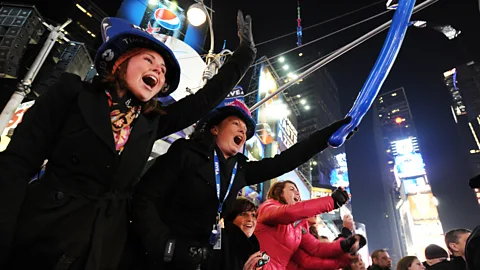 Stan Honda/Getty Images
Stan Honda/Getty ImagesThe idea of marking the new year by dropping an oversized object at midnight has since spread across the world. Bermuda drops an illuminated onion. In the Canadian province of New Brunswick, it’s a maple leaf; and in Boise, Idaho, a potato.
But just as the New Year’s Eve drop took hold, the time ball was on the way out. By the 1920s, the technology was outdated, rapidly replaced by radio, quartz clocks, and now GPS. Most towers were torn down, and the iron machinery scrapped.
“There’s no practical point in the time ball system now,” said Jacob of the Sydney Observatory, which once provided the time to the state of New South Wales.
But the astronomer, who admits that he usually checks the time on his mobile phone, believes it’s important topreserve this largely forgotten daily ceremony.
“Re-enacting it each day reminds us things were much more complex and organised in the past than we might think. It was fundamental to the state, to commerce, to international trade,” he said.
 Ramin Talaie/Getty Images
Ramin Talaie/Getty ImagesToday the audience might be limited to a few cruise ship passengers who have wandered up from Sydney Harbour and visiting school groups. Still, there’s still a certain thrill to releasing the ball to mark the one o’clock hour. “It makes a whoosh and it settles down to the bottom,” he said. “It’s fun to do.”
And even if time ball towers haven’t endured, the tradition certainly has. Although Wauchope might be aghast at the hoopla, come 31 December, his invention will again take the global stage, doing exactly what it was designed to do: simply and precisely noting the passage of time.
If you liked this story, sign up for the weekly bbc.com features newsletter called "The Essential List". A handpicked selection of stories from BBC Future, Culture, Worklife and Travel, delivered to your inbox every Friday.
{"image":{"pid":""}}
